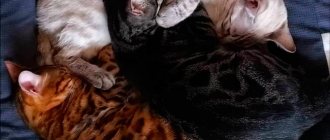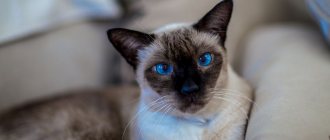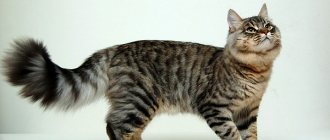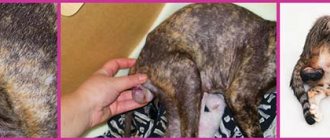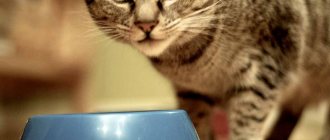History of the origin of the breed
The homeland of Siamese cats is Thailand, which in ancient times was called Siam, hence the name of the cat. The breed has an ancient past. In Thailand, “moon diamond” cats, as the locals romantically called cats, were known already in the 14th century. Siamese cats were considered sacred animals and were only owned by monks and members of the royal family. Until the 19th century, Europe and America knew nothing about the unusual breed - cats were forbidden to be exported from the country.
Read : what to name a Siamese cat.
In Europe, the first cats were introduced to the public at an exhibition at the Crystal Palace Cat Show in 1871. The first Siamese cat was brought to the United States as a gift to Lucy Hayes, the wife of President Rutherford B. Hayes in 1878. David brought the cat. B. Sickels is an American diplomat stationed at the consulate in Thailand.
The breed was not immediately able to gain popularity among cat lovers - these oriental beauties had too exotic an exterior. Today this breed is very popular and recognized by all international cat associations.
Character
From childhood, we all remember the statement that Siamese are terribly evil. But actually it is not. Although the character of this breed is still the same. These long-tailed cats are in no way suitable for people who prefer cats as sofa cushions with which they can do whatever they want. The fact is that representatives of the Siamese breed are very smart, and their innate nobility will manifest itself in literally everything, bordering on selfishness. These animals are sure that they were born to be given attention, pampered and loved. Many Siamese do not tolerate other four-legged animals around them; in their opinion, only they are the absolute masters of the home.
There is no way to ignore the Siamese's demands. The deep and melodic, but at the same time very loud voice of the cat will sound until the lady of the apartment gets what she wants. When a cat reaches puberty and begins to persistently demand dates, the apartment will be filled with a huge range of different notes, which can turn into a real howl, clearly audible outside the home. Cats calling cats announce the surroundings with equally powerful cries.
The Siamese is not a toy for entertainment at all. The blue-eyed girl will not sit on your arms and tolerate your tenderness if they try to caress her against her will. After all, independence is another strong point of character. But if the cat itself jumped onto your lap, please be patient until Her Majesty rests or receives her portion of adoration.
Representatives of the breed are very active and playful. But if handled carelessly, the claws instantly come into play. The resentment will last a long time, and even if you have already been forgiven, the cat will still treat you with caution for some time.
If you offend a Siamese cat, he will easily give back
But the devotion of the Siamese can be compared to that of a dog. If a cat has chosen an owner, she will be faithful to him to the end, showing the whole gamut of her feelings - love, hatred, and resentment. And your affection and attention to her will pay off handsomely. The cat will meet only the chosen one at the threshold and purr news or complaints into his ear. And believe me, Siamese are very talkative. Showing feelings, a restless aristocrat can turn the house upside down, and then lie down in her arms as if nothing had happened, looking lovingly into your eyes. A feeling of deep affection can cause depression, which the Siamese will experience if the owner ignores him for any reason or is absent for a long time.
Siamese cats are waiting for their owner to take a shower - video
Intelligent and savvy by nature, representatives of the breed are highly trainable, especially if it is done in a playful way. And then they are happy to demonstrate their skills (but only at their own request).
Siamese kitten brings a toy - video
Another advantage of the breed is their excellent adaptation to new conditions. But despite this, Siamese do not really like changing their place of residence.
All the character qualities inherent in the breed, of course, exist, but when getting a pet, remember that only your attention and understanding can turn an imp into a real angel.
Appearance
The Siamese cat is distinguished by its special gracefulness, diminutiveness and a certain majesty that is characteristic of its character. Siamese kittens are the only ones that have not been crossed with cats from Europe, which has preserved the pristine nature of their eastern roots.
Breed standard according to the WCF system
- Body . Elongated, elegant proportions. Not large. Slim and muscular.
- Head. It has a wedge shape. The wedge starts at the tip of the nose, then widens in straight lines to the ears.
- Muzzle. Narrow.
- Neck. Slender and long.
- Ears. Positioned as a continuation of the wedge of the head. Very big. Wide at the base and narrowed at the tips.
- Chin. Forms a vertical line with the tip of the nose.
- Nose. Straight and long.
- Eyes. Almond shaped. Rich blue color. Located at a slight angle.
- Limbs. Slender and long. The hind ones are longer than the front ones.
- Paws. Oval, graceful shape.
- Tail. Thin at the base and along the entire length, very flexible and long. The tip of the tail is pointed.
- Wool. Short without undercoat. Glossy and silky. Fits tightly to the body.
- Color. There are about 20 varieties of colors. A prerequisite is the presence of “points” - spots darker than the main color on the face, ears, paws and tail.
- Weight. Not described in the breed standard. From 3 to 6 kg.
- Height at withers . Not described in the breed standard. From 23 to 25 cm.
- Lifespan . Representatives of the breed are considered long-livers. On average they live from 14 to 25 years.
Important!
The Guinness Book of Records records a Siamese cat that lived for 38 years.
About the origin of the Siamese cat
When you see the heavenly eyes of a Siamese, you want to know where this cute creature comes from. History does not have a specific answer to this question regarding the origin of the wonderful Siamese cats, classified today as this breed. We have to be content with beautiful legends, and each of them may well exist with a certain degree of probability.
According to one legend, the first representative of the mustachioed purrs from Siam arose on Noah's ark and was the result of crossing a monkey with a lion. A fantastic hypothesis, but there is also a second one, indicating a small break at the tip of the tail in cats. According to legend, the Princess of Siam, while bathing, kept her jewelry by stringing it on the tail of her beloved cat, and tying the end into a knot. The story tells something similar: the purring Chula protected the gold cup of Buddha by wrapping her tail around it. The kittens that were born from her also had this feature, as well as squint.
It is known that the state of Siam - now Thailand - can be considered the birthplace of the cat. Siamese favorites were held in high esteem and lived only in noble and wealthy houses. By the way, such a variety of the breed as Thai also came from there.
In Europe, the first pair appeared at the end of the 19th century in the form of a gift presented by the King of Siam to the British Ambassador Owen Hood. Since then, this breed began to gain popularity, and in 1892 the 1st standard was recorded. The latter was changed in 1902 in favor of the modern appearance of cats.
Colors of Siamese cats with photos
There are more than 20 varieties of Siamese cat colors.
The most famous colors of Siamese cats are as follows:
- Seal point (brown) is a cream color that can have shades to light brown. The points of this color are dark brown.
- Blue point (blue) is a snow-white color with a bluish tint to the points.
- Red point – white body, red (apricot) point. There may be streaks on the markings, which is not an abnormality.
- Caramel point (light cream). This color is slightly different from the traditional one, since the cat is neither white nor brown. Its color is a magnolia shade, and its points are gray-pink.
- Chocolate point (black). The body is ivory in color, and the markings can range from chocolate (café au lait) to black.
- Cinnamon point (ivory shade). The cat's body is ivory-colored, like a "chocolate" point, but the markings are pinkish-brown.
- Lilac point (pink). The cat's body is the color of beaten egg white, and the markings are light gray with pink tints.
- The Torty Point is a rather unusual color, distinguished by a colored mask and the same markings on the paws, tail and ears.
- The Tabby Point is distinguished by the fact that the markings have stripes. The body is pale, without shades (plain color).
Important!
The points are the result of the albinism modifier gene and appear as the cat grows older in colder areas of the body. Kittens are born completely white. With age they darken. In colder regions, Siamese cats have darker spots.
Care and maintenance
Shorthaired Siamese cats are clean by nature and require minimal grooming.
The most important thing is to provide cats with sufficient attention from the owner, care and affection. Then the myths about the breed’s viciousness of these cats will remain exclusively myths. In an atmosphere of love and care, these beauties turn into gentle, affectionate and devoted pets.
Content Features
Cats have very short hair with no undercoat, so they are very sensitive to cold. They can only be kept warm, in a place without drafts. The optimal temperature for kittens is 25-28°C.
If Siamese are kept in a cool room, it is necessary to insulate the resting place and organize a warm bed. During the cold season, you can place a heating pad wrapped in a towel on the mat. The breed is completely unsuited to being kept outdoors.
Cats are smart and quick-witted, they easily learn to walk on a leash (harness). Their habits are very similar to those of a dog; cats of this breed can be taught commands and tricks. Siamese love long walks and don’t mind going on trips themselves, so you need to keep an eye on windows and entrance doors. If left open, cats may escape.
Siamese cats are very sensitive, they can distinguish the intonations of a human voice and understand words. Besides, they are touchy. If you scold or punish your pet undeservedly, he may harbor a grudge and try to take revenge. Raising a Siamese kitten and an adult animal is necessary in an atmosphere of calm and love. Cats can become attached to one family member, choosing him as their owner. They experience separation from this person very painfully.
Siamese cats are active and love active games; they can run around the house for hours. It is important that they have enough space. All dangerous devices, electrical wires, and breakable furnishings must be removed out of the reach of cats. Please note that Siamese are very curious; the blood of a hunter and explorer flows in their veins. Cats can climb into closets, bedside tables, washing machines and other unexpected places.
In the absence of their owners, they can play pranks, sometimes their pranks have a destructive effect. Overturned flower pots, unwound balls and rolls of toilet paper, a reprogrammed TV receiver - all this may be waiting for you when you return home after work. Cats have nimble and very long fingers, and they quickly learn to use them.
To prevent your cat from destroying the apartment out of boredom and longing for its owners, buy it several logical puzzle toys. Siamese are smart, they enjoy playing with such toys. To implement cat activity, you can build or purchase a vertical multi-level house or play complex. But the best escape from boredom for a cat is a companion animal. Ideal companions for Siamese can be small active dogs or relatives with a similar temperament.
Smart cats learn to use the litter box quickly. The main motivators for them in this process are your attention and praise. The whip method should not be used with these cats. Unpleasant notes in the voice, coercion - all this will be perceived with hostility by the wayward and freedom-loving Siamese. An offended kitten may completely forget how to go to the litter box. Sometimes adult pets do this too - this is how they express protest and punish the owner.
Features of care
Cats have smooth, very short fur and no undercoat. These cats do not need to be combed - just run a damp hand or a massage mitt over the fur to collect dead hairs. And sometimes clean the fur on the ears with a piece of velvet cloth. But caring owners do not neglect this procedure; they brush their cats weekly with a wide-toothed comb or a brush with natural bristles. To add shine to the coat at the end of the procedure, use suede.
Siamese don't like water. They don't like her in a panic. They have no undercoat - cats are cold all the time. Therefore, there is no need to rape an animal. Cats are bathed very rarely, only if their fur is heavily soiled with sticky, foul-smelling substances (oil, resin, paint). Immediately after the procedure, dry your pet and wrap it in a warm, dry towel. To quickly dry the animal, you can use a hairdryer.
Oriental beauties have a predisposition to dental problems. Sufficient attention should be paid to caring for the oral cavity and teeth. Your teeth should be examined and brushed weekly using a special toothpaste and brush. Siamese dogs are taught this procedure, which is not very pleasant for cats, from an early age. To cleanse the oral cavity, cats are given special treats. To promptly detect and remove tartar, pets are taken to a veterinarian.
The breed actively uses a scratching post, this is how the claws are worn down naturally. If this is not enough, you need to trim the claws with a nail clipper and trim them with a special nail file. This must be done carefully and very carefully. Remember that Siamese are sensitive, if you hurt them, cats may be offended. Ask your veterinarian to show you how to trim nails correctly.
Your pet's large ears should be inspected once a week to check for unpleasant odors, crusts, and unnatural discharge. All this is a reason to take your cat to the veterinarian. If everything is fine with the ears, they are cleaned with a cotton swab dipped in Vaseline oil. Cotton swabs are not suitable for cleaning cat ears. The veterinarian may recommend another product from a veterinary pharmacy to clean the ears.
The beauty's almond-shaped eyes can sometimes turn sour. If this happens rarely and the discharge from the eyes is colorless and odorless, there is no reason to worry. It is enough to examine and wipe your pet’s eyes with a cotton pad dipped in warm boiled water. Purulent and profuse discharge is a reason to consult a veterinarian.
Siamese cats are incredibly clean. Therefore, owners will have to wash bowls with hot water immediately after eating. You need to do this every day. The feeding area must also be kept clean.
Siamese do not like unpleasant odors and may refuse to eat in a dirty place. Also, you need to carefully clean the cat's litter box - clean Siamese will not do their business in a dirty litter box.
Important!
Place the tray as far away as possible from the place where food and water bowls are located. Siamese will not eat where they are toileting. Food bowls are placed in a secluded, quiet place.
What age is best to take
Under standard conditions, a kitten can leave its mother at 12 weeks of age. In any case, this should definitely happen no earlier than 8 weeks after birth. There are three very important aspects to the start of a kitten's life. The end of breastfeeding should be gradual. Breastfeeding for a kitten is not just about eating, but about feeling safe, communicating with the mother and learning. Weaning on solid food begins at 4-5 weeks.
Under natural conditions, the mother catches a mouse, kills it, brings it back and eats it in the presence of the kittens. This way, they can watch the process and, over time, taste it. Then the mother brings back live prey to teach the babies hunting skills. On average, the transition from breast milk to solid food occurs gradually and lasts up to 8-10 weeks . So, from the point of view of care, when the kitten can already eat on its own and has reached 10 weeks of age, it is time for it to separate from its mother.
Important! All three developmental stages are important in a kitten's later life. There is also the point of view of vaccination. However, the age of vaccination varies from country to country and, in most cases, the first vaccinations are given no earlier than 8 weeks of age.
A mother has to teach her baby a whole bunch of things. For kittens, the period of active socialization occurs from 2 to 8 weeks of life. Babies learn everything by watching their mother. These are the skills of safety, communication with people and with each other, using a litter box, etc. Even if the new home has a worthy example in the person of an adult cat, it has been proven that kittens still learn these skills from their mother faster and better.
It is important for kittens to play with their littermates until they are 12 to 14 weeks old. These games go through several difficult stages as they age, which cannot be noticed by the untrained eye. The game helps develop hunting behavior and coordination of movements. It is an important tool that promotes environmental exploration, stimulates the maturation of the central nervous system, and helps to bond and form social structures with other cats. Games teach kittens pain. This applies to both personal feelings and understanding of what actions bring pain to other individuals.
So, it turns out that the earliest age at which a kitten can be taken away from its mother is 8 weeks. If the baby is properly weaned from the mother's breast, the process can take up to 8-10 weeks. As a rule, play between kittens stops by 12 weeks; at this age they begin to play with toys and can be moved to another home in the most comfortable conditions.
Return to content
How much money do you need for care and maintenance?
What to buy for a kitten
Required set:
- Two or three bowls (depending on the type of feeding). Choose a large water bowl - Siamese often like to drink from large containers. Price: 150 – 320 rub.
- Tray. Large with deep sides: 250 – 1350 rub.
- Wide-toothed comb or brush with natural bristles: RUB 350 – 650.
- Scratching post: 900 – 2500 rub.
- Toys. Choose intellectual ones and those that you can run after. Price: 600 – 3500 rub.
- Plastic carrier with metal door. Price: 1250 – 2600 rub.
- Bed. Warm with sides: 500 – 2000 rubles.
Additional products:
- Vertical game complex. Price: 5000 – 32000 rub.
- Claw cutter. Price: 350 – 590 rub.
- Harness with leash. Price: 850 – 1600 rub.
- Anti-cat bars for windows. Price: 1800-2450 rub.
- Automatic drinking fountain. Some Siamese cats love to drink running water. Price: 1800 – 4800 rub.
The annual care of a Siamese cat may require from 20 to 40 thousand rubles.
The budget will depend on your capabilities, the chosen diet, the type of filler and the health of the pet.
Health and illness
Genetic breed abnormalities
The Siamese cat has congenital pathologies that are unique to this breed:
- Congenital strabismus. Visual impairment due to pathology of the development of the eyeball. Develops in cats with the acromelanism gene (Siamese, Thai). The gene affects the ability to see the world in a stereoscopic dimension. Because of this feature, Siamese see everything in a flat image.
- Broken tail. A crease in the tail is a sign of a breed defect. Curvature of the vertebrae leads to permanent pinching of nerve endings. Cats with this defect constantly experience pain and discomfort and can be aggressive because of this.
Important!
In the USSR it was believed that a real Siamese cat should have a kink in its tail and slanted eyes. In addition, they must be aggressive and vindictive. This happened due to the fact that it was very expensive to introduce a real purebred animal into the country; they brought rejected animals with developmental anomalies.
Other health problems
The unique wedge-shaped shape of the head and jaws means that cats of this breed swallow food without chewing. Because of this, plaque and tartar form, and periodontal disease develops. It is important to regularly care for the oral cavity and teeth, and choose food of such a shape and size that the cat is forced to chew it.
The lack of undercoat and the wedge-shaped narrow head of the cat make the animal vulnerable to various respiratory diseases. It is important to prevent your pet from becoming hypothermic, not to allow him to drink cold water, or to be in a draft.
Siamese cats often have:
- Amyloidosis. A pathology in which protein is deposited in the liver and kidneys of an animal. Causes chronic renal and liver failure.
- Glaucoma. Occurs due to increased eye pressure. May lead to retinal atrophy and blindness.
- Bronchial asthma.
- Hyperthyroidism. Pathology of the thyroid gland. Possible increased appetite, thirst, weight loss.
- Aortic stenosis. Congenital heart pathology, characterized by narrowing of the aortic opening. With this pathology, blood circulation is impaired.
- Dilated cardiomyopathy (enlargement of the heart). Genetic pathology leading to heart failure.
Important!
Keep in mind that Siamese cats are highly sensitive to anesthesia and this factor is important to consider when performing operations.
Prevention methods
To avoid these health problems, you need to take a responsible approach to choosing a kitten, ask the breeders for its documents and the documents of its parents, as well as the results of genetic tests.
The mandatory list of treatment and preventive measures should include:
- vaccination according to schedule;
- antiparasitic treatment;
- anthelmintic measures;
- vitaminization.
If a cat is not purchased for breeding, in the first year of life it is necessary to decide on its sterilization (castration).
Annually, treatment and preventive measures may require from 3,000 to 5,000 rubles.
Choosing a healthy kitten
Light blue eyes are the hallmark of the Siamese breed . A Siamese cat kitten should have a clear look and clean eyes. If the animal cannot focus, the eyes are watery, cloudy or watery too much - this is a sign of a health problem. It is better not to adopt such a kitten.
After you have looked into the baby's eyes, be sure to evaluate the condition of the coat. It must be clean and silky. There are both short-haired and long-haired representatives of the breed, but purity must be present in any type of coat. Cleanliness is a characteristic feature of any cat breed. If an animal does not take care of its fur, it may have health problems. Pay attention to the condition of your skin. There should be no wounds, bald spots or scratches on it.
Important! Examine the animal's oral cavity. The gums should be pink, not too pale or red. A healthy cat's teeth are white. Find out what the kitten is fed; by the time you buy it, it should already be eating solid food.
A healthy cat is active and inquisitive. Make sure the kitten you choose is within the activity range for its age. Pay attention to how he reacts to strangers and other animals - a kitten for sale must be socialized. Feel the baby, he should not be skinny or too plump. A tight, bloated belly may indicate illness or the presence of parasites in the intestines. His ears should be clean, free from roughness, dirt and scratches. These signs may indicate the presence of ear mites.
Return to content
Feeding
The choice of food for a Siamese cat should be approached as responsibly as possible. These exotic oriental beauties are considered too picky when it comes to food and can show fickle tastes. Some of their preferences cause sincere bewilderment among the owners.
For example, a Siamese can happily eat nuts or mushrooms. They also love different fruits. But you shouldn’t indulge your pet; the owner must provide the cat with a balanced, properly selected diet. Whether it is natural food or feeding with ready-made food is up to you.
Natural nutrition
The basis of the natural diet of all cats should be meat. When creating a menu for a Siamese cat, you need to take into account the fact that representatives of this breed have darker fur from excess red meat in their diet. Therefore, 30% of animal proteins should come from fish.
Animal proteins should make up 70% of the menu:
- lean meat (rabbit, beef, turkey, chicken breast, lamb, game);
- sea fish (navaga, cod, tuna, flounder);
- shrimps;
- quail eggs;
- beef liver – 1-2 times a week.
What else should be in the diet:
- skim cheese;
- kefir, yogurt, fermented baked milk;
- vegetables (carrots, broccoli, zucchini, pumpkin, squash, cauliflower);
- fruits (apple, pear, banana) - as a treat;
- olive oil;
- greens (spinach, lettuce);
- Brewer's yeast;
- bran;
- dried seaweed (kelp).
All cats on a natural diet are prescribed vitamin and mineral complexes.
Prohibited products:
- bones (chicken, fish);
- milk;
- sweets;
- flour;
- onion garlic;
- fatty pork;
- sausage;
- legumes;
- smoked meats
- spices.
The daily serving volume is calculated using the formula: 7-7.5% of the cat’s weight. Adult cats need two meals a day.
Important!
Don't forget about access to clean water. It should be open 24/7. Many Siamese love to drink from large dishes and from the tap - pour water into a large container or buy a fountain drinker.
The monthly budget for a natural diet is 1000-1500 rubles.
Industrial feed
When making a choice in favor of one or another ready-made food, you need to assess the condition of your pet, its age and level of mobility. Avoid cheap “economy class” food from the beginning. High-quality brands of the “super-premium” and “holistic” classes are suitable for purebred cats. Do not forget about the breed characteristics - alternate meat and fish compositions.
Recommended brands:
- Orijen Cat Six Fish Grain Free – high-quality dry diet of holistic fish;
- Acana Regionals Grasslands Cat Grain-Free – dry meat and fish formula;
- Bozita Feline Shrimps - Chunks in Sauce - a wet diet based on meat and shrimp;
- 1st Choice Adult Cat Finicky Chicken Formula – for adult picky cats;
- Optima Nova Adult Cat Exquisite Chicken & Rice – with rice and chicken for picky-eating pets;
- AATU For Cats Free Run Chicken - food based on chicken and salmon;
- Royal Canin Siamese Adult – for adult Siamese cats.
The daily feeding rate is calculated based on the age, weight and activity of the pet. On average, Siamese cats need 45-70 grams of dry food per day.
Every month it will cost from 900 to 2300 rubles to feed a cat.
Read more about top cat foods and what to feed Siamese kittens.
Breeders' advice
The key to a successful purchase, according to breeders, is, no matter how strange it may sound, choosing the right breeder. To choose a good nursery you need:
- Inquire about the number of litters per year. Too many kittens is not good. Cats should have breaks between producing offspring. Therefore, if they tell you that kittens are born 1 or 2 times a year and you need to wait, it’s better to wait.
- Ask to see how the animals are placed and whether there are too many of them. A large number of animals require the same amount of affection, the deficiency of which will affect the mental and physical condition of kittens.
A good breeder should:
- Give the kitten away only after 10-12 weeks of life;
- Take an interest in the buyer’s lifestyle and living conditions;
- Provide all necessary documents for the animal and its parents;
- Fully vaccinate all cats living on the territory of the cattery;
- Provide the opportunity to conclude an agreement that guarantees the impeccable health of the pet for a certain period of time.
Return to content
FAQ
How many live at home?
Cats living in a family can live a long life - 15-25 years. Among the representatives of the breed there are long-lived cats that have lived for more than 35 years.
What is the weight of an adult and a kitten?
Siamese cats are slightly larger than females. At three months, cats weigh 1-1.5 kg, females - 1.3-2.8 kg. By six months, cats reach a weight of 1.7-2.4 kg, males - 2.3-4.1 kg. Adult females weigh 3.1-4.2 kg, males - 4-6.1 kg.
Is it easy to hold?
Siamese are affectionate and gentle towards their people. They can walk on their hands and sit on their knees. There are individuals who greet you at the doorstep and ask to be held in your arms. They may not go to strangers.
Can I keep it outside?
No. These cats are very sensitive to cold. They cannot be kept even in a cold room.
How aggressive is the breed?
The aggressiveness of Siamese cats is legendary. But these are just legends. True purebred Siamese are affectionate pets that become attached to people. The myth of vindictiveness and aggressiveness appeared in the Soviet years, when cats with genetic defects and psychological problems were imported into the country. Modern purebred Siamese are smart, willful, but not aggressive.
Do they like to claw/climb?
They love you if they are bored. Don't leave your pets alone for long periods of time and provide them with toys they can play with while you're away.
Is this breed hypoallergenic?
The short-haired Siamese poses a potential danger to allergy sufferers. The Balinese cat, which is sometimes called the longhaired Siamese, is considered less allergenic and is related to the Siamese.
Do you need to take care of your fur?
Minimal grooming is required - the breed has short hair without undercoat. Some owners simply run a damp hand over the animal's fur to remove dead hair. You can brush your Siamese once a week with a natural bristle brush or a sparse comb.
What color are eyes?
Cats of this breed have rich blue or blue eyes. Do not believe those who offer you a purebred Siamese cat with a different eye color. Green, copper and yellow colors are a breed defect.
Is the breed prone to heart disease?
Unfortunately, Siamese cats have a hereditary predisposition to heart pathologies. Such as heart enlargement and aortic stenosis.
At what age do they stop growing?
Siamese kittens reach adult size by 2 years. By this time, the color of the coat and eyes should have finally formed. In some individuals, the growth process is completely completed at 1.5 years.
Reviews from Siamese cat owners
Kirill : “I named my Siamese cat Klitschko. Moreover, initially he was Piglet, but the fighting qualities of the cat determined his name and future fate. They say that Siamese cats are fighters. They say the truth. But, respecting my cat, I will say that people have never suffered from his long claws, but furniture and curtains have suffered regularly! Klitschko, my friend, is stubborn. He immediately refused to eat ready-made food, even though I offered him the most expensive options, he only eats human food, including bread and butter and caramels. I know it’s harmful, but that’s how it happened historically.”
Nikita : “When the blue-eyed kitten from the entire litter jumped into my arms, the bearded engineer’s heart trembled. I named it Pepper, in the hope that it will grow into a cool pepper. Pepper is still growing. What can I say - the character, like all Siamese, is sharp. Firstly, he decided that the bathroom was a wonderful toilet, large and white, and so far he could not be dissuaded. Secondly, this impudent guy only sleeps on my head. It feels like I'm growing another beard at night. But that's where its shortcomings end. Perchik is a real man’s cat, brutal and childish at the same time.”
Slava : “Very often cats with a similar color are called Siamese. This is where the myth about their aggressiveness, vindictiveness and sloppiness came from. In fact, true Siamese cats are an elegant breed in every sense. They are delicate and unobtrusive, even when they miss their owner, Siamese cats do not beg for affection, but intelligently wait for it. Of course, familiarity is not in their favor, but if you remember this, you can build a wonderful partnership with your Siamese cat.”
Video reviews:
What you need to know about the habits and character of the Siamese cat
According to an old legend, royal Siamese cats protected the temples of Siam; it is not without reason that the intelligence of these pets exceeds that of other feline representatives. These pets are easy to train and learn to adjust their behavior with the help of a caring owner. The Siamese cat is capable of learning some tricks, which makes it possible to compare its habits with a dog.
Siamese have a fairly loud voice. The cat's mind can appreciate such an ability to use this skill for blackmail. For example, in an attempt to demand the required item from the owner. It’s time to dedicate a separate section in the book to the power of voice timbre and beauty.
Thanks to the proper upbringing of a purebred pet, he will be able to get along perfectly with the family, go to the litter tray regularly and will not scratch children. Reviews from admirers of the Siamese breed help to reveal not very good character traits, for example, vindictiveness and rancor. However, if the pet is not provoked and one remembers these features during the training process, then there will be no reason for him to remember evil intentions. The Royal Siamese will express its natural nature, for example, in catching mice. However, the cat's temper will have to be taken into account, and children should be warned about this.
The Siamese cat does not exactly like dogs, and the above description of its vindictive disposition will come in handy.
How much does a Siamese kitten cost?
The average price for a Siamese kitten is 8,000 – 35,000 rubles (5,000 – 10,000 UAH).
What does the price depend on?
Price formation is influenced by:
- kitten class;
- floor;
- colors;
- age;
- prestige of the nursery;
- parents' titles;
- sale with or without breeding rights;
- pedigree.
The biggest influence on the cost is belonging to a certain class:
- SHOW (show) – kittens are sold with the right to breed and are allowed to participate in exhibitions and competitions. Price: from 25,000 to 45,000 rubles;
- BREED - healthy kittens without genetic pathologies and good characteristics, have minor deviations from the standard, can be exhibited and allowed for breeding. They cost from 10,000 to 15,000 rubles.
- PET (pet) - pets without the right to breed, are not allowed to exhibitions. Price: from 3,000 to 10,000 rubles.
Choosing a kitten class
The division of cats into classes was invented by breeders in order to better understand their physiological quality in the future . This classification is informal. Kittens are placed into classes immediately after birth. Babies from the same litter can belong to different classes, and subsequently the class of each of them can also change. There are 3 classes - show, breed and pet.
Show class animals are the best representatives of cats, they fully comply with all the characteristics of the breed and have excellent exhibition prospects. These kittens are the standard of the breed. They can be sold in co-ownership or with certain conditions; finding them is a great success. The price of such an animal will be the highest of all classes.
The main purpose of the breeding class is childbearing and breeding. They are great for breeding. Cats in this class have good pedigree and reproductive traits. With the right approach to care and breeding, breed-class animals can produce show-class kittens. Breed class cats can also participate in exhibitions and receive titles, but this happens less often. They are not much cheaper than show class cats, but among them you can find a show class kitten in which all its advantages have simply not been considered.
Pet class kittens are not of exhibition or breeding interest to the breeder. They may have some defects that distinguish them from breed standards, but do not affect the health of the animal. Such cats are usually bought for the soul. These are affectionate pets that match the character of the breed. Kittens are sold only if sterilized. This is also indicated in the documents.
Return to content
